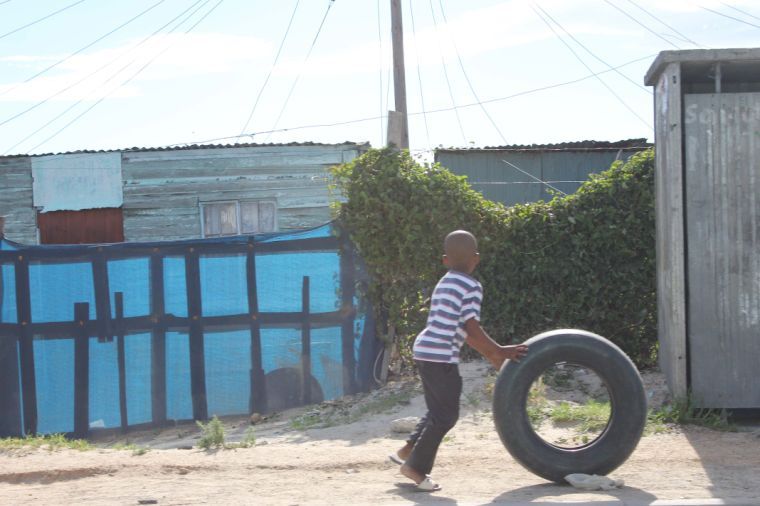A helping hand abroad, at home
January 22, 2014
“We’re fighting for the crumbs,” said Faeza Meyer, a resident of Cape Flats, a neighborhood that covers 32 acres within the city of Cape Town, known as the “slums” of South Africa. When I visited the area over winter break, I noticed that the houses are in close quarters to each other and composed of sheets of wood and metal so that light seeps through the cracks. Garbage can be found piled up in the corner, and flies buzz about between two of the houses. There is no such thing as indoor plumbing, only communal outhouses or Porta Potties. Children run barefoot along paths that have shards of glass sticking out from the ground.
I initially came upon the winter break study abroad program in Cape Town, South Africa, to get credit for my Global Studies major while learning in another country. By the second day of our two-week class, “Globalization and Insurgent Spaces,” the professor introduced us to local community activists from Cape Flats.
During the 1950s, Cape Flats was the area where the government would displace non-whites during the Apartheid. One of the activists was Meyer, the chairperson of the Housing Assembly, an organization that addresses the various inequalities found in the area. She joined the initiative not because she sought it, she said, but because it found her. For Meyer, life in Cape Flats is one continuous cycle, where people are constantly moving from one settlement to another due to eviction. She said there are around 450,000 people who are currently applying for housing, a number that doesn’t include foreigners.
During our visit to the impoverished neighborhood, children came running toward our group, in awe at the sight of visitors. I’m not one for children, but when I felt a little boy’s hand grab mine, I started to tear up. The toddler, who had lived his whole life in compromising circumstances, demonstrated so much openness toward me — he had brought me to tears by just simply reaching out to a stranger. We spent the rest of the day with them, playing games like soccer and painting the children’s faces.
When we left, almost every kid in that settlement watched us walk across the street to our vans. Although the experience was heartwarming, I came to a hard realization: No matter how much I cared about them, it may not be enough to really change the lives of these kids.
Get The Daily Illini in your inbox!
We often disregard and oversee the poverty that surrounds us. The Champaign-Urbana area is not only home to our University, a world-class research institution — it’s also home to world-class issues of inequality and struggle. In Champaign county, 22.1 percent of people live below the poverty level, according to the 2012 census, which is higher than the state average of 13.7 percent. Just look north of University Ave., and one can see how these injustices aren’t limited to third- or even second-world countries. The poor of Champaign may not live in shacks, but they do face lack of access to basic resources that we, as students, are fortunate to have.
It’s easy to be sympathetic when you’re traveling abroad with a class or volunteer organization. But when everything is said and done, we return to our comfortable lives, leaving behind the experiences in a distant but sentimental memory. Most of the time, we don’t know how any the people we have supposedly “helped” will end up. I can only hope that the little girl who hugged my neck the whole time in Cape Flats will not succumb to teen pregnancy, or the little boy I painted a mustache on during the community project day will not join a gang. I will hope, because I will probably never know. But I do know, however, that I am aware of a dire situation of inequality in Cape Town — no person’s home should be reduced to a house of metal and wood scraps.
Now that I am back in Champaign, in my nice, cozy apartment (complete with a washer and dryer in-unit), I am left with the question of how can I do more to help the people I’ve left behind. Although I am honestly concerned about the situation those people face, I am here in chilly Illinois and they are approximately 8,494 miles away. Donating money is always the go-to option, but I believe that throwing money at problems and not knowing how it’s spent is just as worthless as not acknowledging the situation.
Being there for those people and dedicating time to their cause would prove to be the best solution. Although that is not feasible at this point in my life, what is feasible is acknowledging the situations of poverty and inequality that surround me in the community, and dedicate time to a local cause — one that I know I can impact. This semester I enrolled in a class called “Spanish in the Community,” where students have the opportunity to volunteer in the community’s schools and organizations.
I left Cape Town with a heavy heart and an equally heavy mind, asking myself what the best way was to care and help those who are less fortunate than me. One of my South African friends taught us the phrase “Unutu ngumtu ngabantu Ubuntu,” which, translated from the African language Xhosa, means “A person is a person through other people.”
Krizia is a senior in LAS. She can be reached at [email protected].







